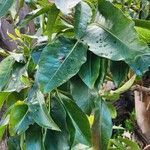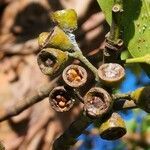Trees, to 20 m tall, d.b.h. to 50 cm. Bark blackish brown, ± persistent, rigid. Branchlets at first flat and ridged but becoming terete, puberulous. Leaves clustered at apex of branches, pseudo-whorled; petiole 1-2 cm, flattened; leaf blade oblong to ovate-lanceolate, 7-15 × 3-7 cm, leathery, abaxially sometimes gray ish, adaxially with subdermal pellucid punctate oily glands, secondary veins 12-18 on each side of midvein, 3-6 mm apart, at an angle of 50°-60° from midvein, and abaxially slightly raised, reticulate veins conspicuous, base cuneate, apex acuminate to sharply pointed. Cymes axillary, 2-3 cm, 3-7-flowered; peduncle 0.6-1.5 cm. Pedicel 3-6 mm. Hypanthium obconic, 4-5 mm, grayish white sericeous. Sepals triangular, 4-5 mm, apex sharply pointed. Petals obovate-rounded, ca. 6 mm, outer surface pubescent. Stamen bundles 1-1.2 cm; filaments partly distinct; anthers ca. 0.5 mm. Capsule semiglobose, 8-10 mm in diam., enclosed in hypanthium, apex truncate. Fl. May-Jul, fr. Aug-Sep.
More
Tree 5–30 m tall, 1.3 m girth, with longitudinally furrowed stringy bark.. Leaves in whorls of 4–5, elliptic to lanceolate, 7–17 cm long, 2–6.5 cm wide, acute to acuminate at apex.. Flowers scented, in few-flowered axillary cymes.. Calyx long white-hairy; lobes narrow and acute.. Petals white.. Stamens in 5 bundles with linear claws as long as petals.. Fruit hemispherical to cup-shaped, 7–10 mm long, 9–12 mm wide.. Fig. 3, p. 12.









